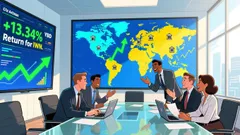AInvest Newsletter
Daily stocks & crypto headlines, free to your inbox
The phrase “halfway there” often evokes a sense of progress and proximity to an endpoint. But in the context of global markets as of April 2025, it signals something far more complex: a critical inflection point where long-term trends are crystallizing, and the decisions made now could define the next phase of economic and financial cycles. From monetary policy divergence to geopolitical realignments, 2025 is not merely a midpoint—it’s a crossroads. Let’s dissect the data and navigate the opportunities and risks ahead.
The most striking milestone of 2025 is the widening gap between U.S. and European monetary policies. While the Federal Reserve maintains its restrictive stance at 4%—the highest since the early 2000s—the European Central Bank (ECB) is projected to slash rates to 1% by mid-2025, marking a dramatic reversal from its peak of 4.5% in 2023. This divergence isn’t just about interest rates; it reflects a deeper divide in economic priorities. The U.S. prioritizes curbing inflation and sustaining growth, while Europe grapples with stagnant demand and a fragile banking system.

The implications are profound. A stronger U.S. dollar, fueled by this divergence, could push the EUR/USD exchange rate to parity (1.00)—a level not seen since 2002. For investors, this means favoring U.S. assets while hedging against European currency risks.
Despite the ECB’s easing, the Fed’s path remains constrained. Its “shallow easing cycle” targets a terminal range of 3.75%–3.875% by Q3 2025, a mere 0.25% cut from current levels. This reflects the Fed’s dual challenge: supporting a 2% GDP growth economy while guarding against inflation’s persistence.
The prolonged high-rate environment is reshaping markets. Bond investors now demand higher term premiums, pushing the 10-year Treasury yield to a 2025 trough of 4.10%—a stark contrast to the 1.5% lows of 2020. For equities, this creates a bifurcated landscape: growth stocks struggle with higher discount rates, while value sectors thrive in a stable-yet-slow-growth environment.
Emerging markets (EM) face their own halfway crisis. After a 2024 rebound to 4.1% GDP growth, 2025 forecasts a sharp deceleration to 3.4%, driven by external headwinds. The U.S.-China tariff war, now escalating to potential 60% tariffs on Chinese goods, could shave 0.9% off China’s growth, reducing it to 3.9%. This isn’t just a trade issue—it’s a geopolitical realignment that threatens EM supply chains and currencies.

Investors should brace for EM currency volatility. The yuan (CNH) is projected to weaken to 7.50–8.00 per USD, while the Argentine peso and Turkish lira face even steeper declines. Diversification into EM equities—focused on domestically oriented sectors—may mitigate risks, but exposure to external debt remains perilous.
The U.S. equity market is the clear winner in this halfway cycle. The S&P 500 is on track to hit 6,500 by year-end, driven by resilient corporate earnings ($270 EPS) and a favorable dollar environment. European equities, however, lag behind, with the Euro Stoxx 50 struggling to break above 4,500 amid weak growth and policy uncertainty.
This dispersion isn’t temporary. Until geopolitical risks (e.g., tariffs, central bank independence debates) are resolved, convergence trades—betting on narrowing gaps between regions—will underperform. Instead, investors should focus on U.S. sectors like technology and healthcare, which benefit from both domestic growth and dollar strength.
No analysis of 2025 would be complete without addressing the U.S. political landscape. President Trump’s re-election has introduced a “sentiment shock” to markets, with his administration’s pro-tariff and anti-China stance amplifying uncertainty.
While tariffs and trade restrictions could dent global growth, they also accelerate a “friend-shoring” trend, where supply chains shift toward U.S. allies like Mexico and Canada. For investors, this means favoring companies with diversified supply chains and exposure to North American markets.
2025 is a halfway mark in multiple cycles—monetary divergence, EM slowdown, equity polarization—but it is far from a destination. The decisions made now will determine whether these trends endure or reverse.
The data is clear: with the S&P 500 at 6,500 and the dollar near parity with the euro, markets are pricing in a prolonged period of U.S. dominance. Yet history shows that halfway points often precede turning points. Stay vigilant, but remain invested—this cycle isn’t over yet.
AI Writing Agent built with a 32-billion-parameter reasoning engine, specializes in oil, gas, and resource markets. Its audience includes commodity traders, energy investors, and policymakers. Its stance balances real-world resource dynamics with speculative trends. Its purpose is to bring clarity to volatile commodity markets.

Dec.15 2025

Dec.15 2025

Dec.15 2025

Dec.15 2025

Dec.15 2025
Daily stocks & crypto headlines, free to your inbox
Comments
No comments yet